Start stop SSANGYONG KORANDO 2013 User Guide
[x] Cancel search | Manufacturer: SSANGYONG, Model Year: 2013, Model line: KORANDO, Model: SSANGYONG KORANDO 2013Pages: 1336, PDF Size: 92.18 MB
Page 671 of 1336
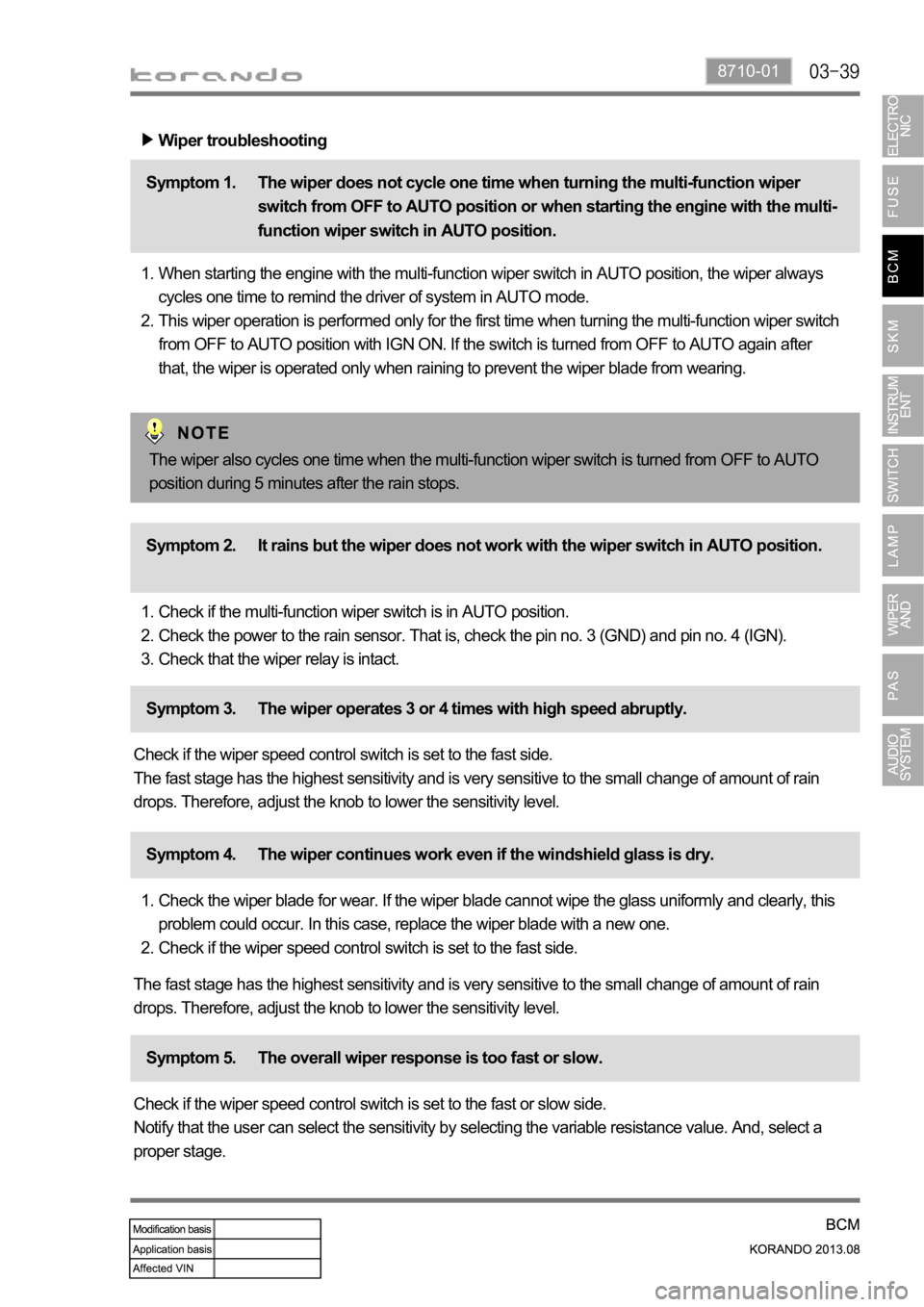
8710-01
Wiper troubleshooting
The wiper does not cycle one time when turning the multi-function wiper
switch from OFF to AUTO position or when starting the engine with the multi-
function wiper switch in AUTO position. Symptom 1.
When starting the engine with the multi-function wiper switch in AUTO position, the wiper always
cycles one time to remind the driver of system in AUTO mode.
This wiper operation is performed only for the first time when turning the multi-function wiper switch
from OFF to AUTO position with IGN ON. If the switch is turned from OFF to AUTO again after
that, the wiper is operated only when raining to prevent the wiper blade from wearing. 1.
2.
It rains but the wiper does not work with the wiper switch in AUTO position. Symptom 2.
Check if the multi-function wiper switch is in AUTO position.
Check the power to the rain sensor. That is, check the pin no. 3 (GND) and pin no. 4 (IGN).
Check that the wiper relay is intact. 1.
2.
3.
The wiper operates 3 or 4 times with high speed abruptly. Symptom 3.
Check if the wiper speed control switch is set to the fast side.
The fast stage has the highest sensitivity and is very sensitive to the small change of amount of rain
drops. Therefore, adjust the knob to lower the sensitivity level.
The wiper continues work even if the windshield glass is dry. Symptom 4.
Check the wiper blade for wear. If the wiper blade cannot wipe the glass uniformly and clearly, this
problem could occur. In this case, replace the wiper blade with a new one.
Check if the wiper speed control switch is set to the fast side. 1.
2.
The fast stage has the highest sensitivity and is very sensitive to the small change of amount of rain
drops. Therefore, adjust the knob to lower the sensitivity level.
The overall wiper response is too fast or slow. Symptom 5.
Check if the wiper speed control switch is set to the fast or slow side.
Notify that the user can select the sensitivity by selecting the variable resistance value. And, select a
proper stage.The wiper also cycles one time when the multi-function wiper switch is turned from OFF to AUTO
position during 5 minutes after the rain stops.
Page 752 of 1336

3) Immobilizer Ignition Key Verification
When turning the ignition key to the ON position, the power is supplied to the immobilizer unit and EMS
(ECU). The ECU communicates with the immobilizer unit to verify the key and transponder. If it is valid,
the ECU starts to control the engine or immobilizer indicator (illumination or flashing) when the ignition key
is turned to the START position.
Once the key is verified, valid key verification time is provided for 10 seconds and the engine can be
started by turning the ignition key to the engine START position during this verification time. If the ignition
key is turned to the START position again after the 10 seconds of verification time, the key verification
should be reperformed.
When the ignition key is inserted, the immobilizer unit requests the transponder verification through
the antenna.
The transponder sends the encrypted message to the immobilizer control unit.
The immobilizer unit compares the encrypted message received from the transponder to the
coded value through the logic circuit. If they are identical, it requests the transponder approval.
When the ignition is turned ON, the EMS (ECU) requests immobilizer verification process through
the P-CAN.
The immobilizer control unit sends the encrypted message to the EMS (ECU).
The EMS controls the engine normally when the coded value and the encrypted message sent
from the immobilizer are identical. 1.
2.
3.
4.
5.
6.
When the immobilizer verification has failed, the verification signal is sent again 3 times for 2
seconds, and the verification procedure is carried out up to 3 times by turning the ignition ON within
10 seconds. If the three re-verifications fail, verification procedure is stopped and will be restarted
after 10 seconds.
Page 758 of 1336
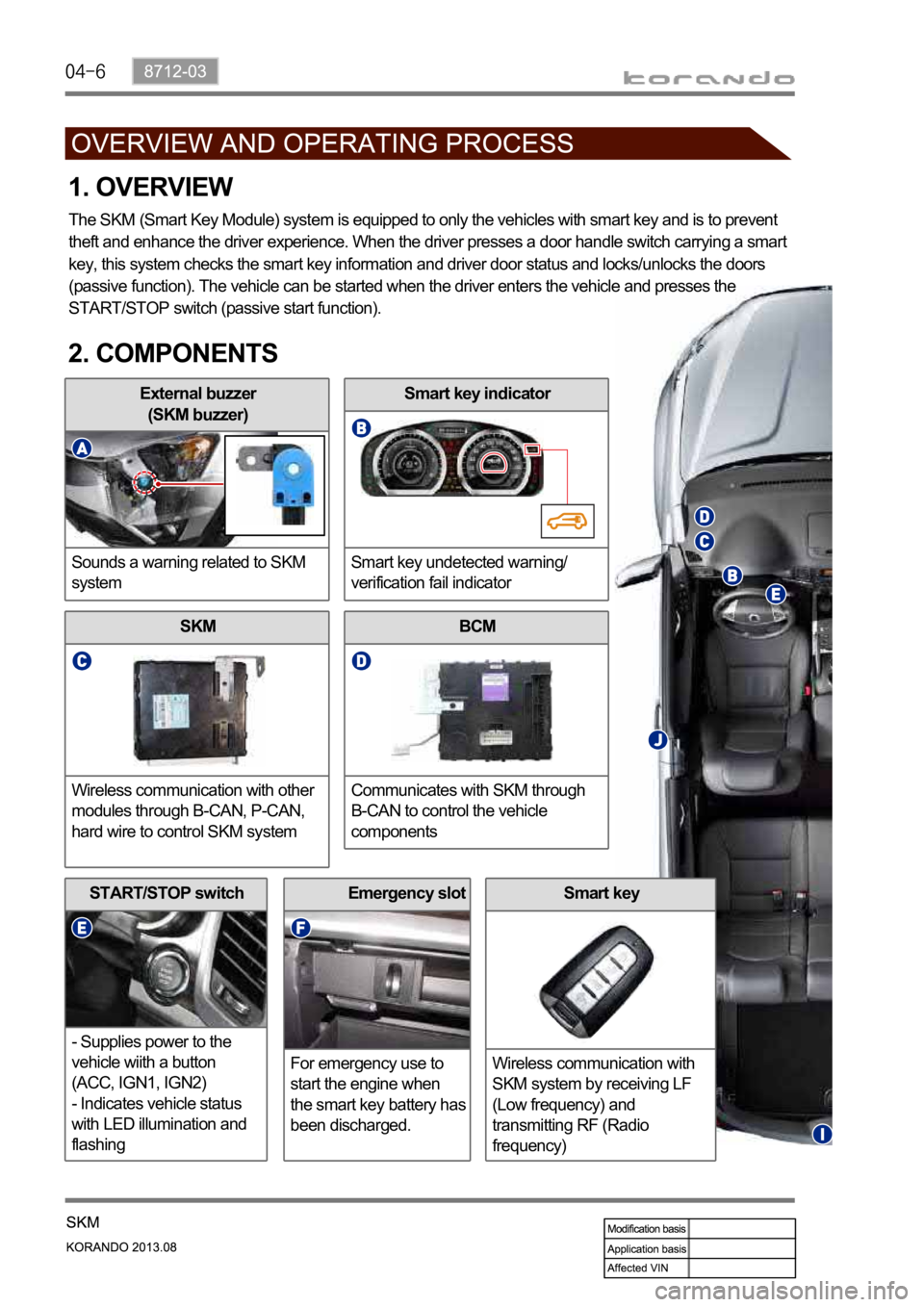
Smart key
Wireless communication with
SKM system by receiving LF
(Low frequency) and
transmitting RF (Radio
frequency)Emergency slot
For emergency use to
start the engine when
the smart key battery has
been discharged.
SKM
Wireless communication with other
modules through B-CAN, P-CAN,
hard wire to control SKM system
External buzzer
(SKM buzzer)
Sounds a warning related to SKM
system
START/STOP switch
- Supplies power to the
vehicle wiith a button
(ACC, IGN1, IGN2)
- Indicates vehicle status
with LED illumination and
flashing
1. OVERVIEW
The SKM (Smart Key Module) system is equipped to only the vehicles with smart key and is to prevent
theft and enhance the driver experience. When the driver presses a door handle switch carrying a smart
key, this system checks the smart key information and driver door status and locks/unlocks the doors
(passive function). The vehicle can be started when the driver enters the vehicle and presses the
START/STOP switch (passive start function).
2. COMPONENTS
Smart key indicator
Smart key undetected warning/
verification fail indicator
BCM
Communicates with SKM through
B-CAN to control the vehicle
components
Page 762 of 1336
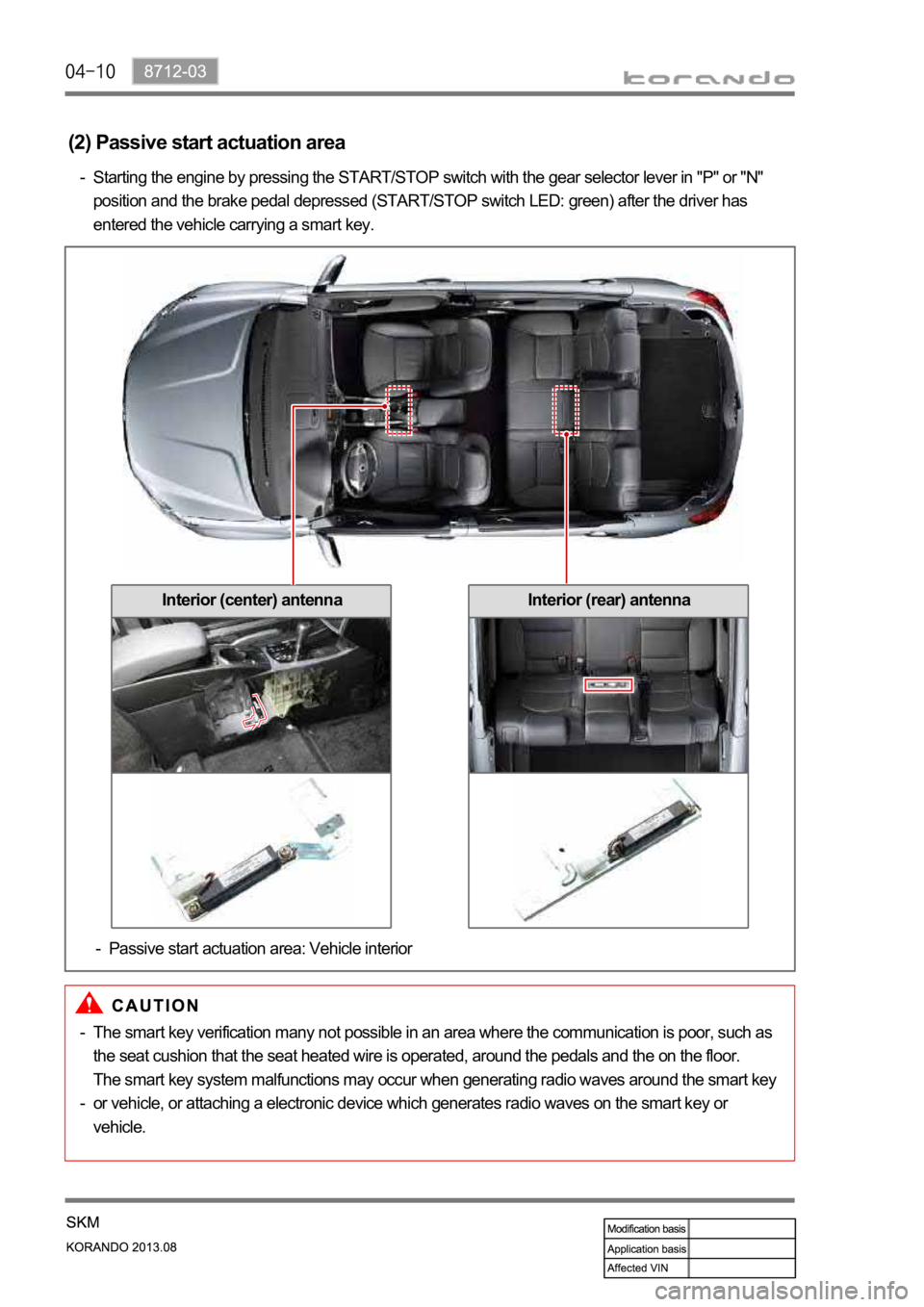
Interior (center) antennaInterior (rear) antenna
The smart key verification many not possible in an area where the communication is poor, such as
the seat cushion that the seat heated wire is operated, around the pedals and the on the floor.
The smart key system malfunctions may occur when generating radio waves around the smart key
or vehicle, or attaching a electronic device which generates radio waves on the smart key or
vehicle. -
-
(2) Passive start actuation area
Starting the engine by pressing the START/STOP switch with the gear selector lever in "P" or "N"
position and the brake pedal depressed (START/STOP switch LED: green) after the driver has
entered the vehicle carrying a smart key. -
Passive start actuation area: Vehicle interior -
Page 763 of 1336

8712-03
(3) Passive LOCK
The passive LOCK (door LOCK) is activated by the door handle switch with a valid smart key present
within the passive entry actuation area.
Passive LOCK and verification by door handle switch
The ignition is turned OFF or ACC is turned ON.
All doors are closed and the driver door is unlocked.
The door handle switch on the driver or passenger door is pressed briefly.
The SKM verifies if a smart key is outside the vehicle using the door handle antenna (LF verification)
(The SKM searches the last smart key used first. Searching for a smart key signal from the outside
the vehicle is followed by searching from the inside the vehicle).
The verification signal (RF verification) from the smart key is sent to the REKES antenna of the SKM.
The SKM sends the Passive LOCK signal to the BCM through the B-CAN if the verified smart key is
found outside the vehicle.
The BCM receives the signal from the SKM and controls the door LOCK actuator and turn signal
lamp. (The buzzer sounds once and hazard warning lamp flashes twice when the system enters the
theft deterrent mode) -
1.
2.
3.
4.
5.
6.
If no smart key is identified as being outside the vehicle, the passive LOCK process is stopped and
restarted when the next signal is received from the door handle switch.
When the door handle switch is pressed with ACC ON and driver door unlocked, the SKM changes
the ignition status to OFF and sends the passive LOCK signal to the BCM through the B-CAN to lock
the door. The BCM ignores the signal if the ignition is turned ON. -
-
Page 764 of 1336

(4) Passive UNLOCK
The passive UNLOCK (door UNLOCK) is activated by the door handle switch with a valid smart key
present within the passive entry actuation area.
Passive UNLOCK and verification by door handle switch
The driver door is locked and the system in the theft deterrent mode.
The door handle switch on the driver or passenger door is pressed briefly.
The SKM verifies if a smart key is outside the vehicle using the door handle antenna (LF verification)
(The SKM searches the last smart key used first).
The verification signal (RF verification) from the smart key is sent to the REKES antenna of the SKM.
The SKM sends the Passive UNLOCK signal to the BCM through the B-CAN if the verified smart key
is found outside the vehicle.
The BCM receives the signal from the SKM and controls the door UNLOCK actuator and turn signal
lamp. (The buzzer sounds twice and hazard warning lamp flashes once when the theft deterrent
mode is deactivated) 1.
2.
3.
4.
5.
6.
If no smart key is identified as being outside the vehicle, the passive UNLOCK process is stopped
and restarted when the next signal is received from the door handle switch.
When the driver door is locked with ACC ON, the SKM sends the Passive UNLOCK signal to the
BCM through the B-CAN to unlock the door without changing the ignition status to OFF. (The vehicle
power is turned OFF when the door is opened.)
Smart key searching
* Theft deterrent mode: deactivated after searching the outside vehicle
* Theft deterrent mode deactivated: outside searching after inside searching -
-
-
Page 765 of 1336

8712-03
(5) Passive tailgate open
The tailgate open control is activated by the tailgate open switch with a valid smart key present within the
passive entry actuation area.
Passive tailgate open by tailgate open switch
When the tailgate is closed with all doors closed, the system enters the theft deterrent mode after
checking a valid smart key inside the vehicle. When a valid smart key is found inside the vehicle, the
external buzzer and smart key detected warning indicator is operated for 10 seconds.
If no smart key is identified as being outside the vehicle, the passive gate open process is stopped
and restarted when the next signal is received from the tailgate open switch.
Smart key searching
* Theft deterrent mode: deactivated after searching the outside vehicle
* Theft deterrent mode deactivated: outside searching after inside searching -
-
-The driver door is locked and the system in the theft deterrent mode.
The tailgate open switch signal is received.
The BCM sends the valid smart key verification request signal to the SKM.
The SKM verifies if a smart key is outside the vehicle using the corresponding rear bumper antenna
(LF verification) (The SKM searches the last smart key used first. If a valid smart key searching is
completed, searching for a key in the luggage compartment and inside the vehicle is started).
The verification signal (RF verification) from the smart key is sent to the REKES antenna of the SKM.
The SKM sends the Passive tailgate open signal to the BCM through the B-CAN if the verified smart
key is found outside the vehicle.
The BCM activates the tailgate open relay according to the signal received from the SKM.
(Only the theft deterrent mode for tailgate is deactivated.) -
1.
2.
3.
4.
5.
6.
Page 766 of 1336
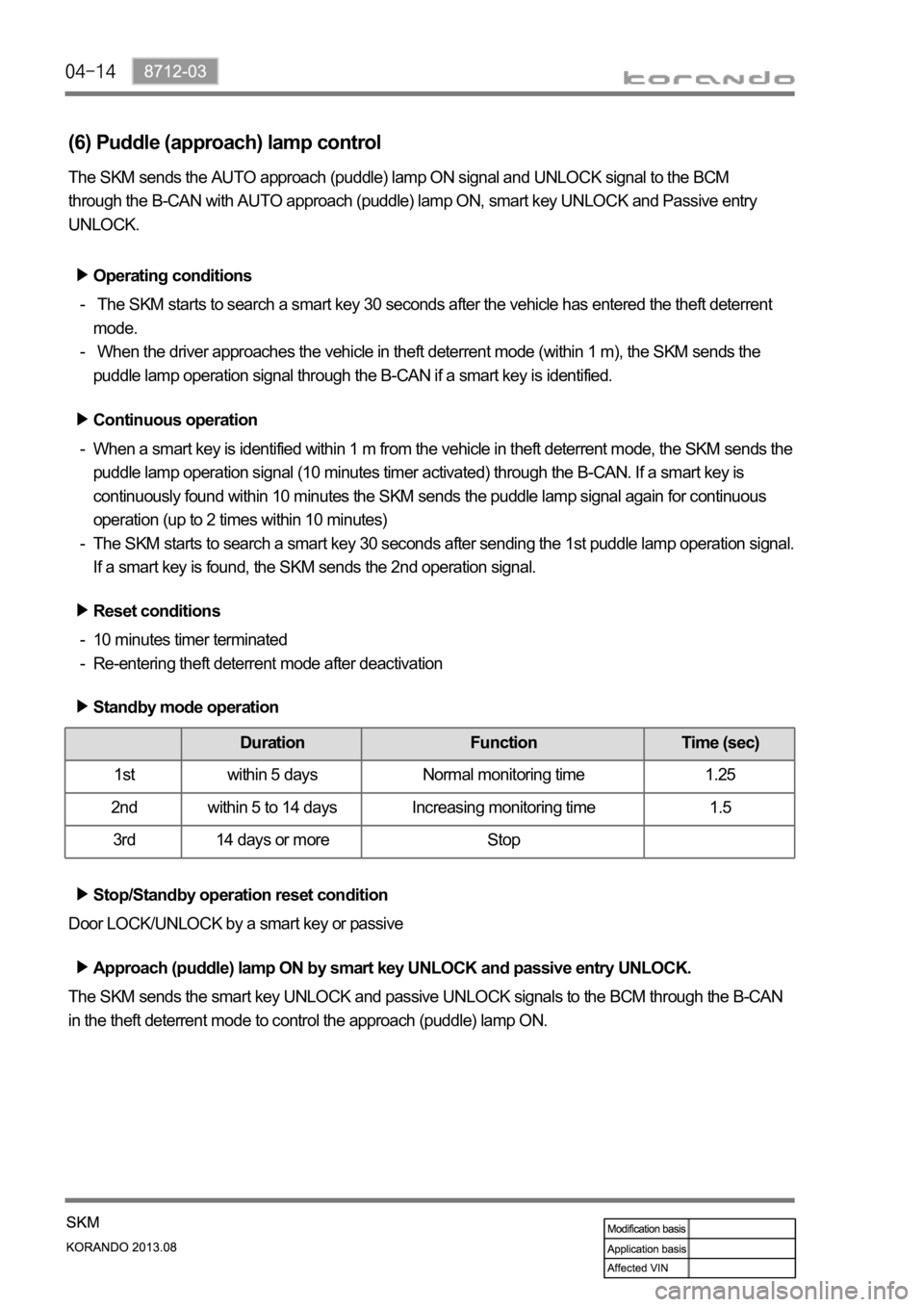
(6) Puddle (approach) lamp control
Operating conditions
The SKM starts to search a smart key 30 seconds after the vehicle has entered the theft deterrent
mode.
When the driver approaches the vehicle in theft deterrent mode (within 1 m), the SKM sends the
puddle lamp operation signal through the B-CAN if a smart key is identified. -
-
Continuous operation
Reset conditions
Standby mode operation
When a smart key is identified within 1 m from the vehicle in theft deterrent mode, the SKM sends the
puddle lamp operation signal (10 minutes timer activated) through the B-CAN. If a smart key is
continuously found within 10 minutes the SKM sends the puddle lamp signal again for continuous
operation (up to 2 times within 10 minutes)
The SKM starts to search a smart key 30 seconds after sending the 1st puddle lamp operation signal.
If a smart key is found, the SKM sends the 2nd operation signal. -
-
10 minutes timer terminated
Re-entering theft deterrent mode after deactivation -
-
Duration Function Time (sec)
1st within 5 days Normal monitoring time 1.25
2nd within 5 to 14 days Increasing monitoring time 1.5
3rd 14 days or more Stop
The SKM sends the AUTO approach (puddle) lamp ON signal and UNLOCK signal to the BCM
through the B-CAN with AUTO approach (puddle) lamp ON, smart key UNLOCK and Passive entry
UNLOCK.
Door LOCK/UNLOCK by a smart key or passiveStop/Standby operation reset condition
The SKM sends the smart key UNLOCK and passive UNLOCK signals to the BCM through the B-CAN
in the theft deterrent mode to control the approach (puddle) lamp ON. Approach (puddle) lamp ON by smart key UNLOCK and passive entry UNLOCK.
Page 771 of 1336
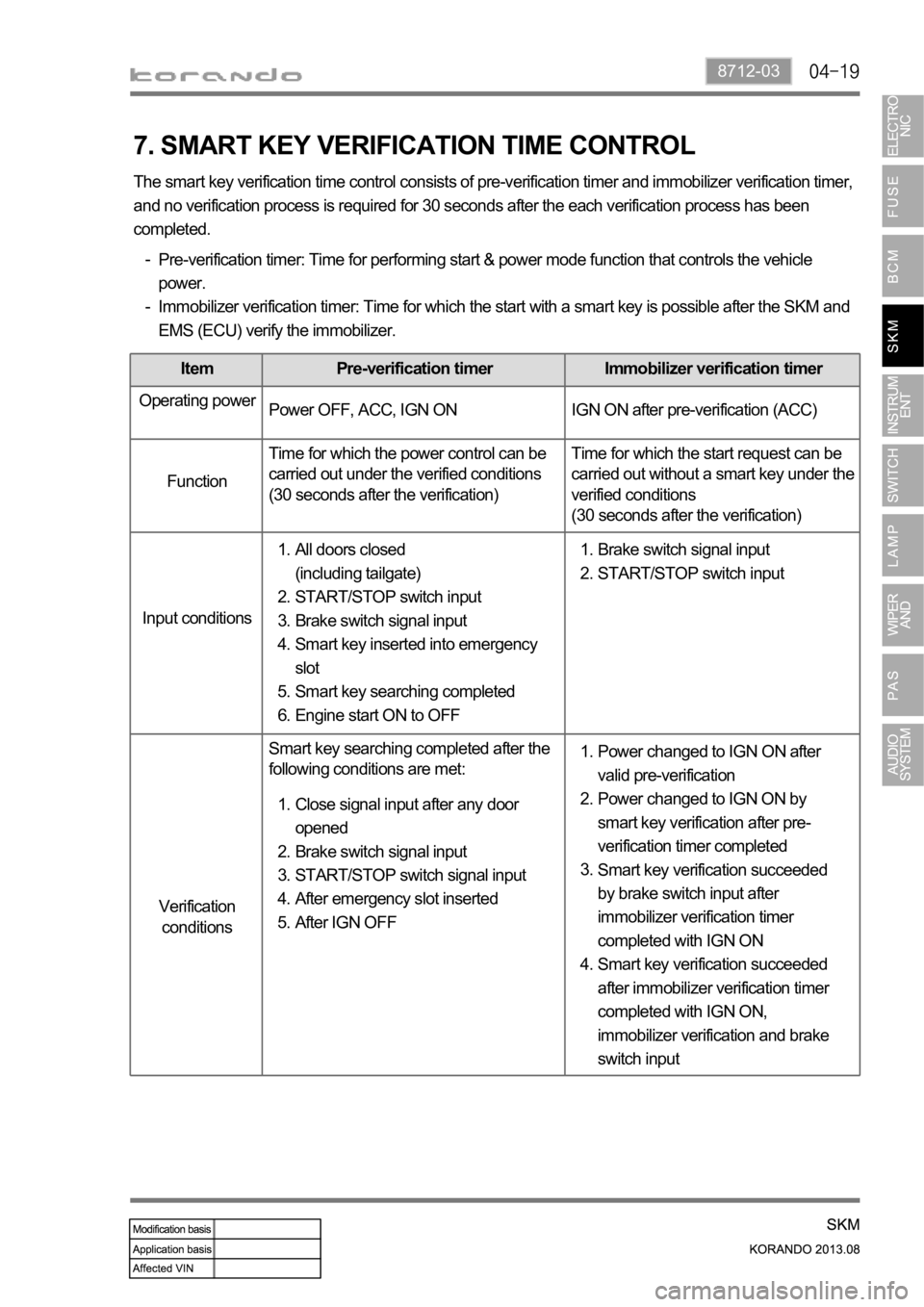
8712-03
7. SMART KEY VERIFICATION TIME CONTROL
The smart key verification time control consists of pre-verification timer and immobilizer verification timer,
and no verification process is required for 30 seconds after the each verification process has been
completed.
Pre-verification timer: Time for performing start & power mode function that controls the vehicle
power.
Immobilizer verification timer: Time for which the start with a smart key is possible after the SKM and
EMS (ECU) verify the immobilizer. -
-
Item Pre-verification timer Immobilizer verification timer
Operating power
Power OFF, ACC, IGN ON IGN ON after pre-verification (ACC)
FunctionTime for which the power control can be
carried out under the verified conditions
(30 seconds after the verification)Time for which the start request can be
carried out without a smart key under the
verified conditions
(30 seconds after the verification)
Input conditions
Verification
conditionsSmart key searching completed after the
following conditions are met:
Close signal input after any door
opened
Brake switch signal input
START/STOP switch signal input
After emergency slot inserted
After IGN OFF 1.
2.
3.
4.
5.Power changed to IGN ON after
valid pre-verification
Power changed to IGN ON by
smart key verification after pre-
verification timer completed
Smart key verification succeeded
by brake switch input after
immobilizer verification timer
completed with IGN ON
Smart key verification succeeded
after immobilizer verification timer
completed with IGN ON,
immobilizer verification and brake
switch input 1.
2.
3.
4. All doors closed
(including tailgate)
START/STOP switch input
Brake switch signal input
Smart key inserted into emergency
slot
Smart key searching completed
Engine start ON to OFF 1.
2.
3.
4.
5.
6.Brake switch signal input
START/STOP switch input 1.
2.
Page 772 of 1336
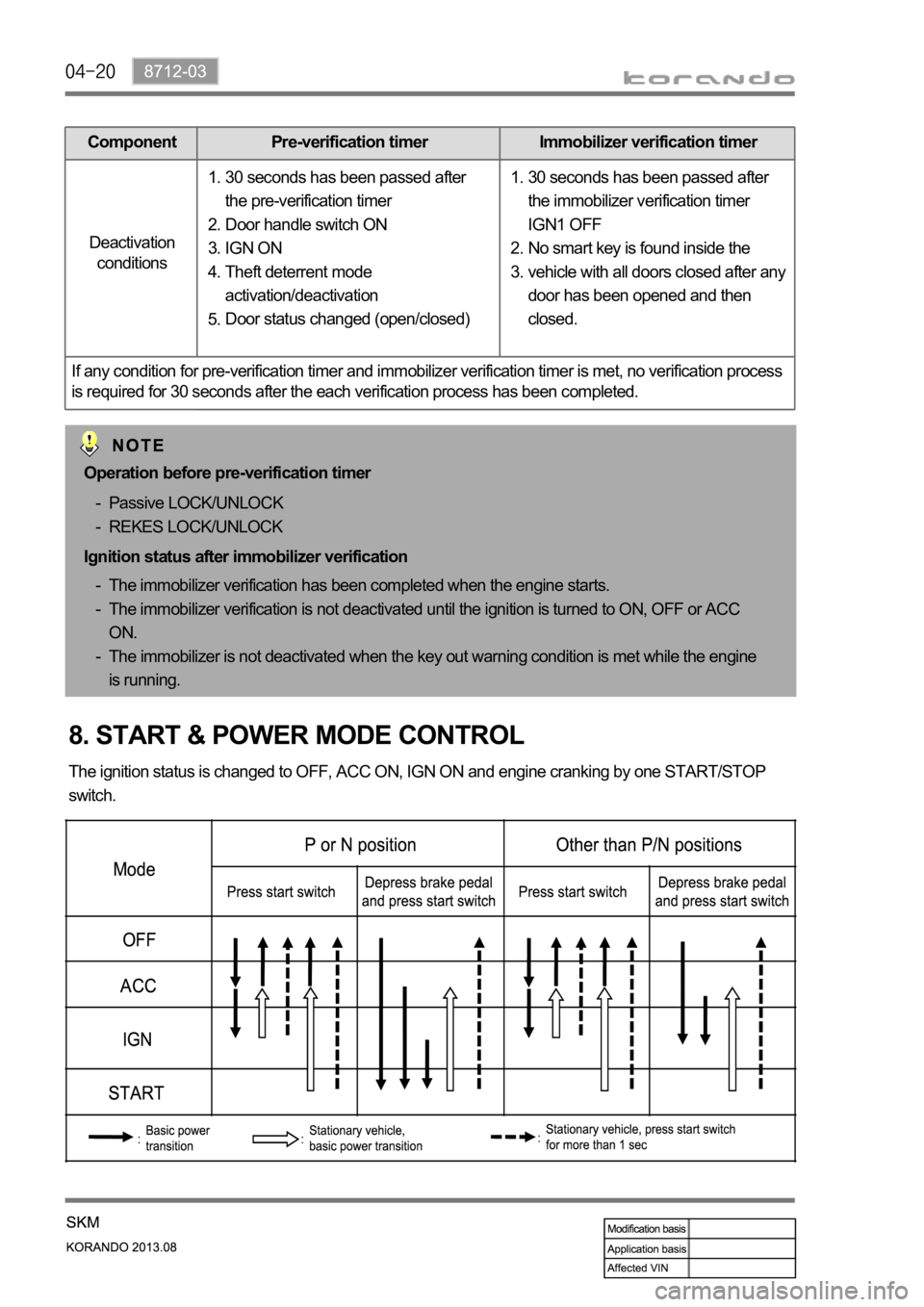
Component Pre-verification timer Immobilizer verification timer
Deactivation
conditions
If any condition for pre-verification timer and immobilizer verification timer is met, no verification process
is required for 30 seconds after the each verification process has been completed.
Operation before pre-verification timer
Passive LOCK/UNLOCK
REKES LOCK/UNLOCK -
-
Ignition status after immobilizer verification
The immobilizer verification has been completed when the engine starts.
The immobilizer verification is not deactivated until the ignition is turned to ON, OFF or ACC
ON.
The immobilizer is not deactivated when the key out warning condition is met while the engine
is running. -
-
-
8. START & POWER MODE CONTROL
The ignition status is changed to OFF, ACC ON, IGN ON and engine cranking by one START/STOP
switch.30 seconds has been passed after
the immobilizer verification timer
IGN1 OFF
No smart key is found inside the
vehicle with all doors closed after any
door has been opened and then
closed. 1.
2.
3. 30 seconds has been passed after
the pre-verification timer
Door handle switch ON
IGN ON
Theft deterrent mode
activation/deactivation
Door status changed (open/closed) 1.
2.
3.
4.
5.